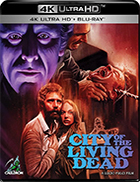City of the Living Dead (Paura nella città dei morti viventi) (4K UHD)
|  The first of Lucio Fulci’s loose “Gates of Hell” trilogy, City of the Living Dead (Paura nella città dei morti viventi, aka The Gates of Hell) is vintage Fulci, which means that it is an extremely gory, narratively nonsensical mishmash of effective Gothic atmosphere and an amateurish desire to be as gross as possible. For every scene that really works, there are two or three that are ham-handed, absurd, or tiresomely grotesque. Fulci, who began his career directing films in virtually every genre imaginable before settling into the horror genre in the late 1970s, never met a gross-out he couldn’t fetishize, and his films are often the cinematic equivalent of rubbing mud, blood, and worms in the audience’s face (which, not incidentally, actually happens to a character in City of the Living Dead). Backs of skulls are ripped off, a character’s head is drilled clean through, and, in the film’s most instantly notorious sequence, a woman vomits up what appears to be the entirety of her internal organs. That particular scene, as it goes on and on and on, becomes a kind of microcosm of Fulci’s simultaneous strength and weakness as a filmmaker: He is very good at orchestrating gross-out moments of epic proportions, but he usually takes them so far that they become comical, rather than horrifying. His delight in drawing out the lead-up to the gross-out forces him into scenes of protracted absurdity, such as the aforementioned drill-through-the-head, the suspense of which he fumbles badly by having the victim lie almost completely still while the drill gets closer and closer, making virtually no effort to get away from the person holding him down because, well, you know—he might get away and then there would be no drill through the head. Co-written by Fulci and his frequent collaborator Dardano Sacchetti, City of the Living Dead, despite its title, actually attempts to move on from Fulci’s previous film, Zombie (1979; aka, Zombi 2), which was a transparent attempt to cash in on George A. Romero’s infinitely superior Night of the Living Dead (1968) and Dawn of the Dead (1978), the latter of which was released in Italy as Zombi (hence Fulci’s film having the otherwise head-scratching title Zombi 2). Rather than simply repeating what had already worked, Fulci and Sacchetti (who also co-wrote Zombie) attempted to steer the film into a more overtly supernatural direction, drawing heavily (although not always very well) on the expansive horrors created by H.P. Lovecraft, which explains why the film is set largely in the fictional New England town of Dunwich. The best moments in City of the Living Dead are the ones in which Fulci creates an unsettling atmosphere of impending dread, which he does quite well with little more than mist, street lights, and camera angles. The story, as much as there is one, begins with a priest (Fabrizio Jovine) hanging himself from a tree in a church graveyard in Dunwich, which somehow opens one the gates of hell (there are apparently numerous said gates, as they also appear in Fulci’s The Beyond and The House by the Cemetery). The opening of the gate is witnessed during a séance in New York by medium Mary Woodhouse (Catriona MacColl), who then teams up with gruff journalist Peter Bell (Christopher George) to try to find and close it. At the same time, strange happenings cause Gerry (Carlo De Mejo), an (overly) level-headed psychiatrist and his patient Sandra (Janet Agren) to also travel to Dunwich to investigate what is happening. There are some other characters, as well, including a mentally deficient pedophile named Bob (Giovanni Lombardo Radice), Gerry’s much-younger girlfriend Emily (Antonella Interlenghi), and Emily’s adolescent brother John-John (Luca Venantin), all of whom have various encounters with the ghost of the hanged priest and the living dead who have been unleashed by his suicide. Unlike Romero’s zombies, though, these have the ability to appear and disappear at will, although they are still driven by the same desire to tear people apart, which said people allow them to do by mostly standing there. As with Fulci’s other gory horror films, City of the Living Dead is alternately tiresome and unintentionally comical, especially for American viewers who will immediately notice that the English-language dialogue was clearly penned by a non-native speaker (you can play a drinking game for every time a character utters an outdated saying like “What the dickens?”). Fulci has a great sense of how to establish atmosphere, but then he blows it time and again by engaging in pointless stylistic overkill, such as his decision to shoot many dialogue scenes with extreme close-ups of the characters’ eyes (it is as if he is trying to channel Sergio Leone, but with no real understanding of the idea of how the face as landscape actually works). There are scenes that function well enough, but then there are ones like the scene in which Sandra calls Gerry over to her house because she found a dead body in her kitchen that promptly disappears while a lot of strange noises echo throughout the house, and he calmly declares that they are going to stay there and find out what is going on. Even by irrational horror-movie-character standards, this defies credulity. Yet, Fulci needs his characters to act like wooden props because that is what makes them so easily victimized, and in the end he cares a lot more about close-ups of squishing brains, flying maggots, and bleeding eyes than he does character, story, or logic.
Copyright © 2023 James Kendrick Thoughts? E-mail James Kendrick All images copyright © Cauldron Films | |||||||||||||||||||||||||||||
Overall Rating: 
 (2)
(2)


